




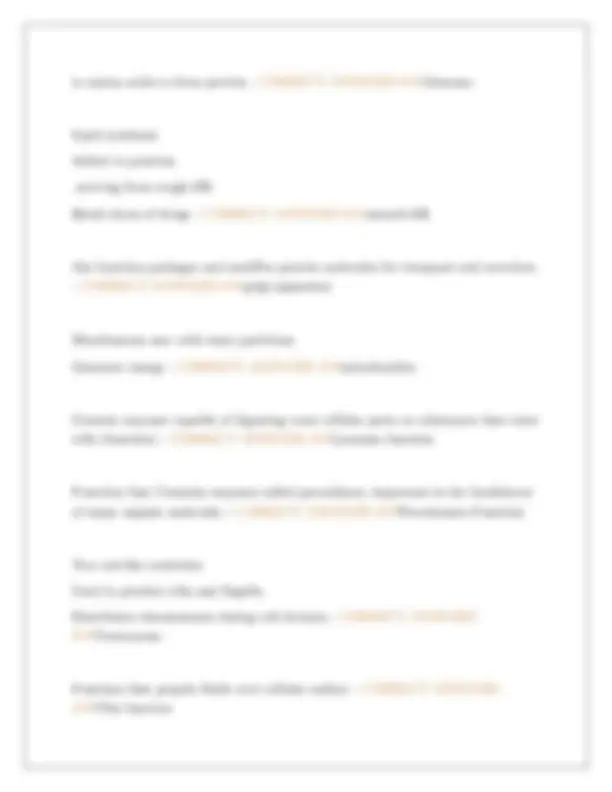

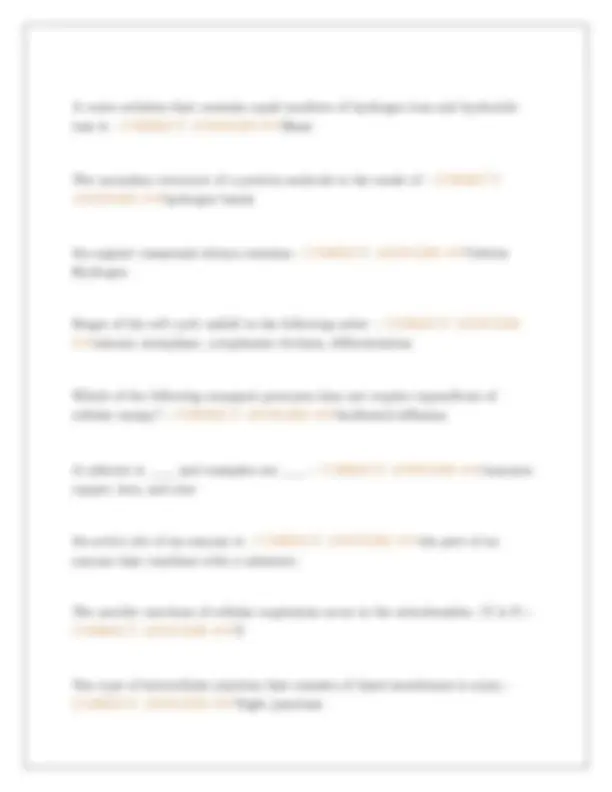



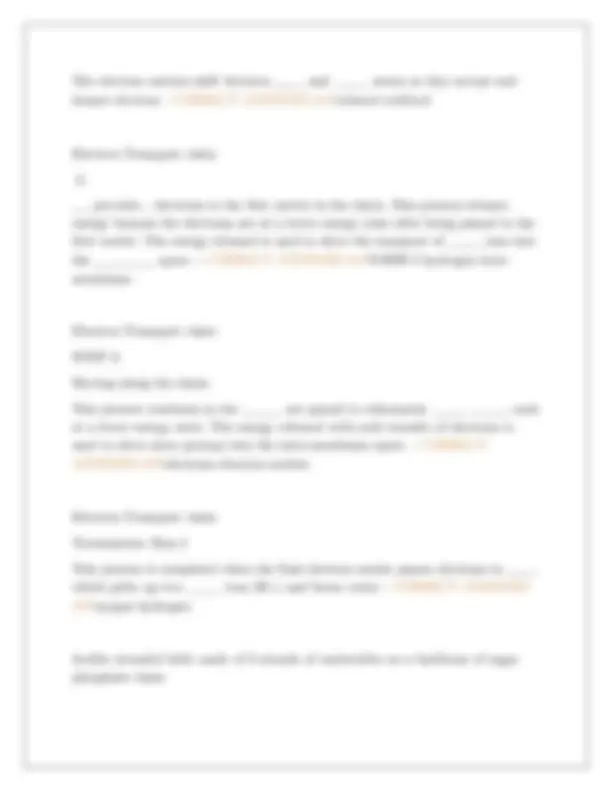


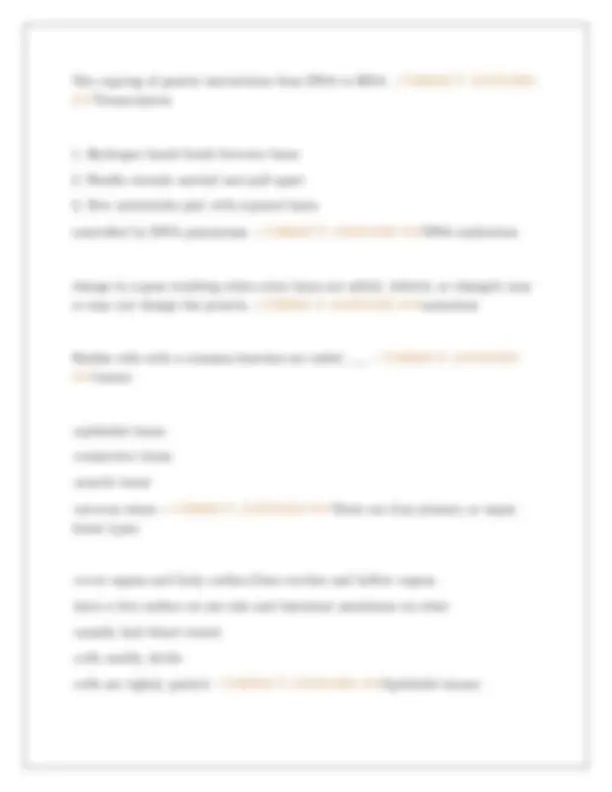
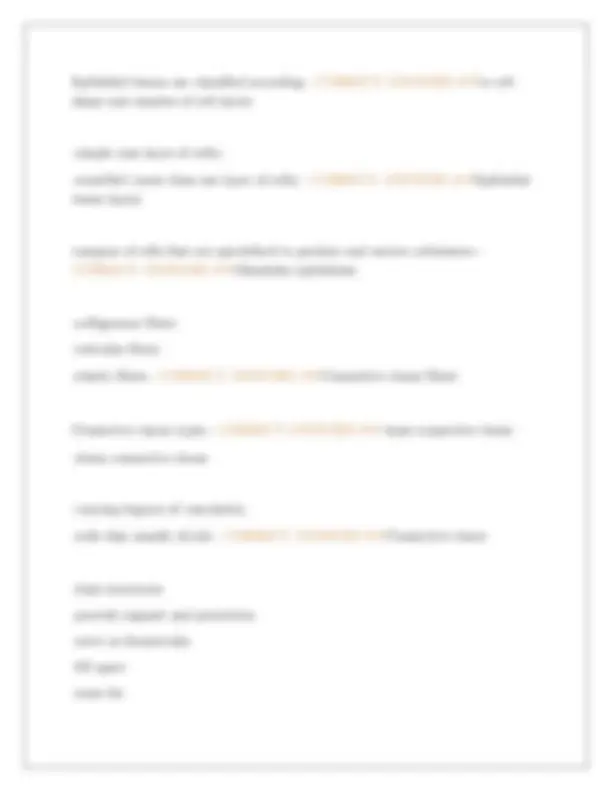
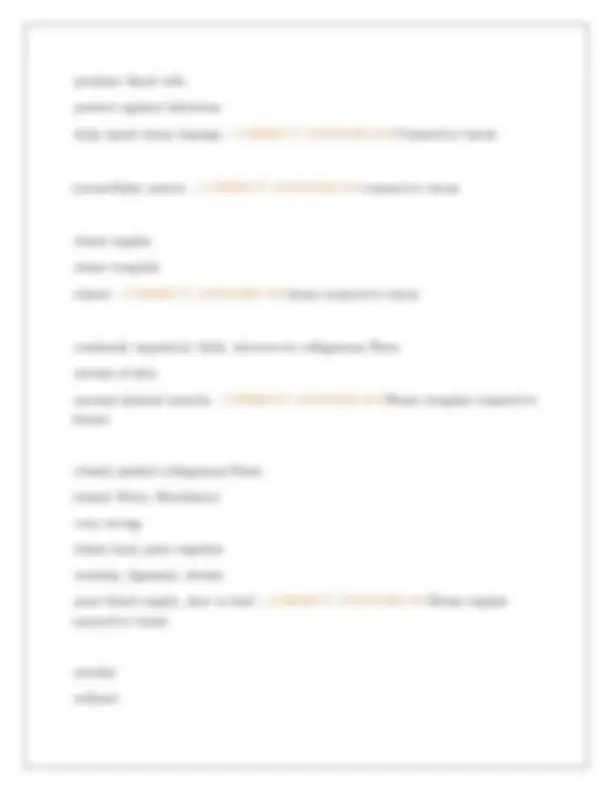

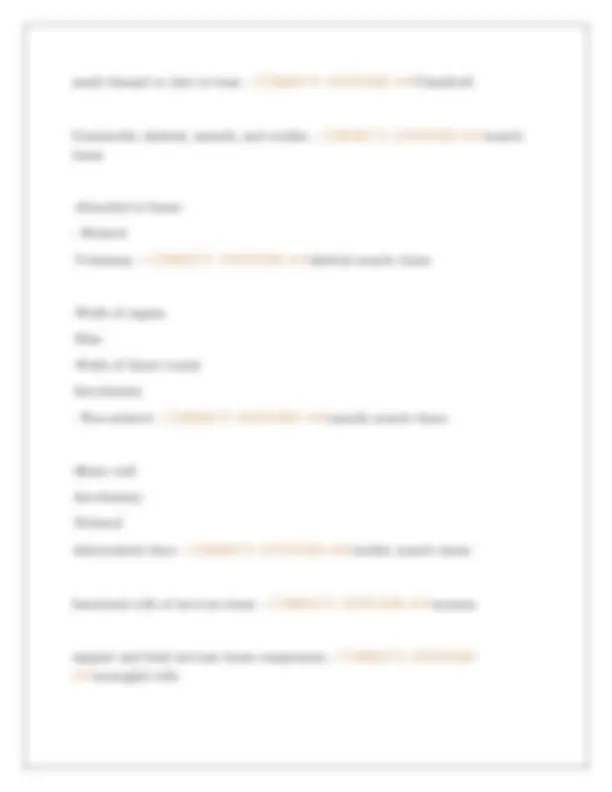
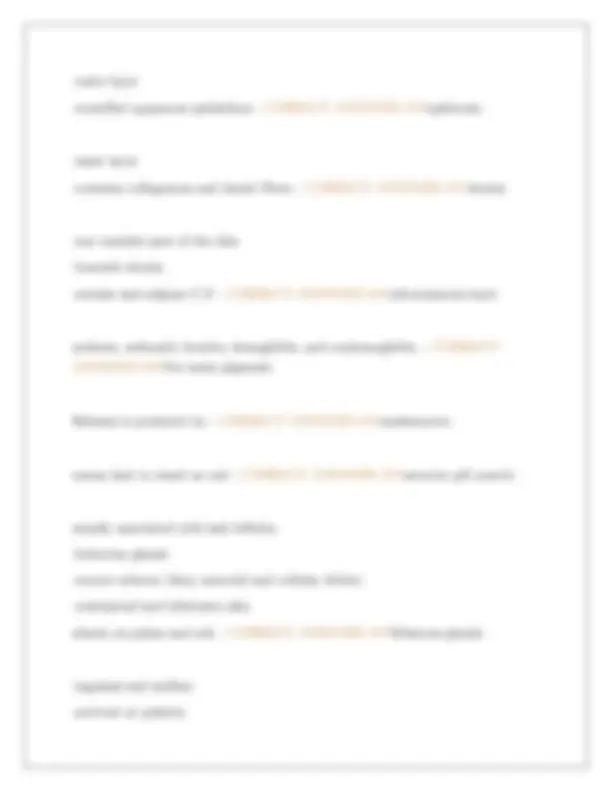
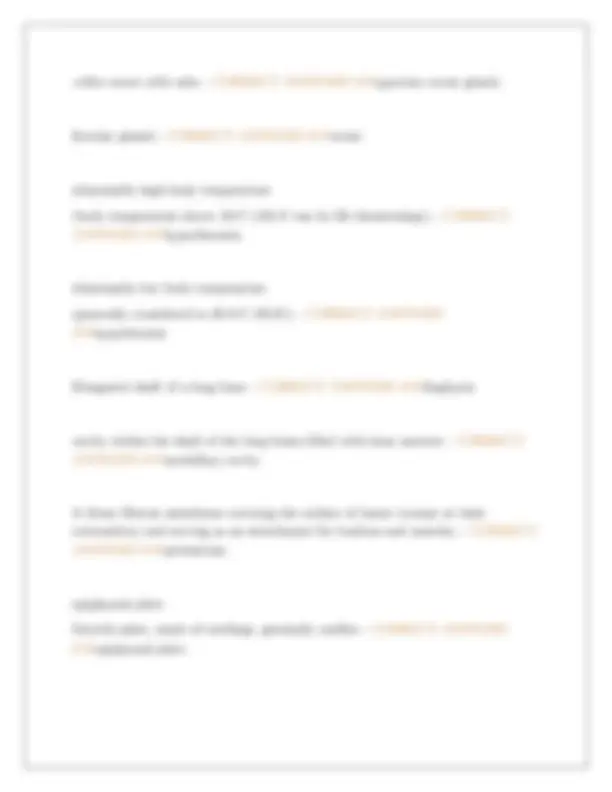
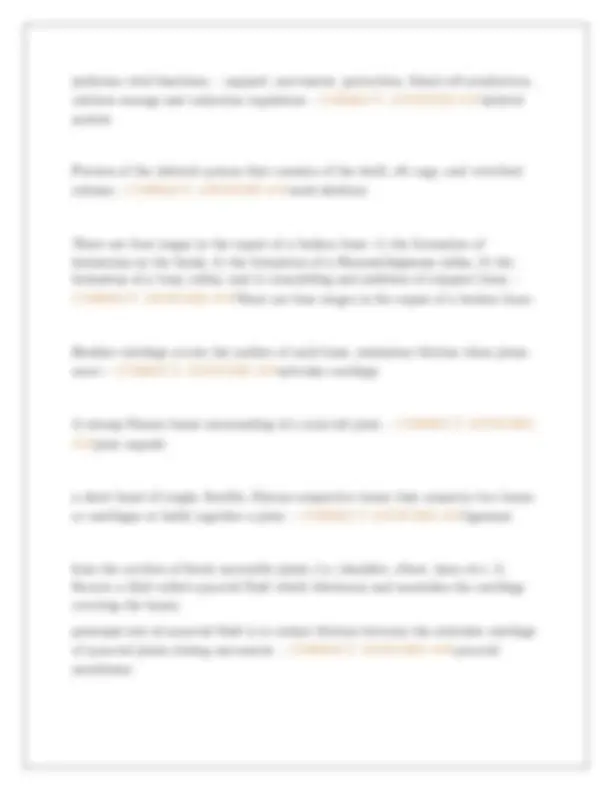

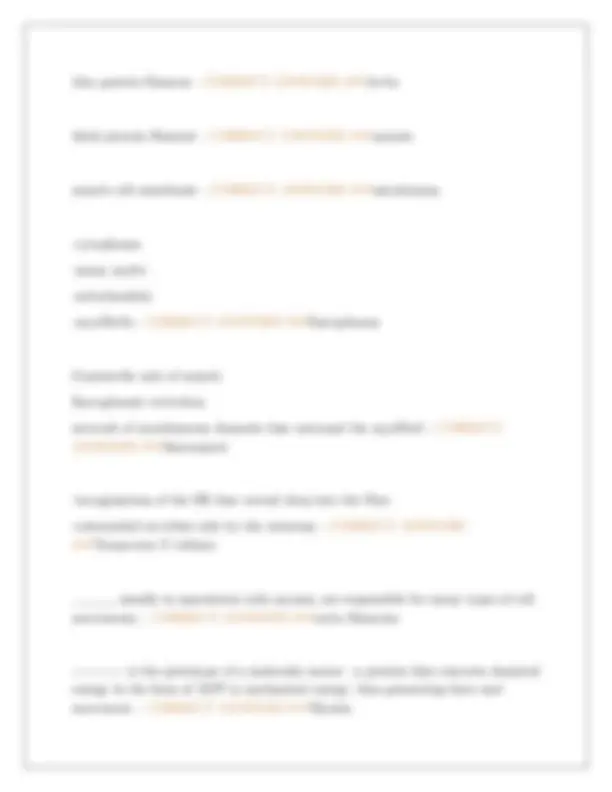
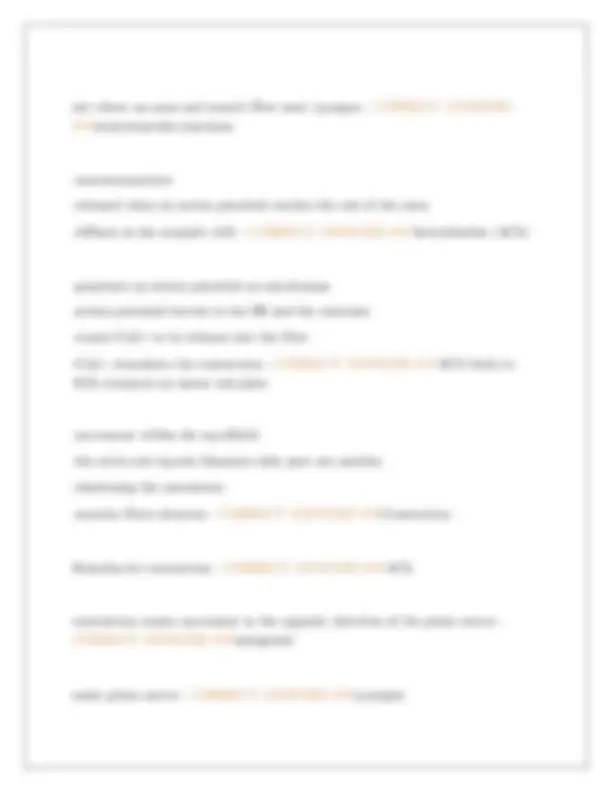



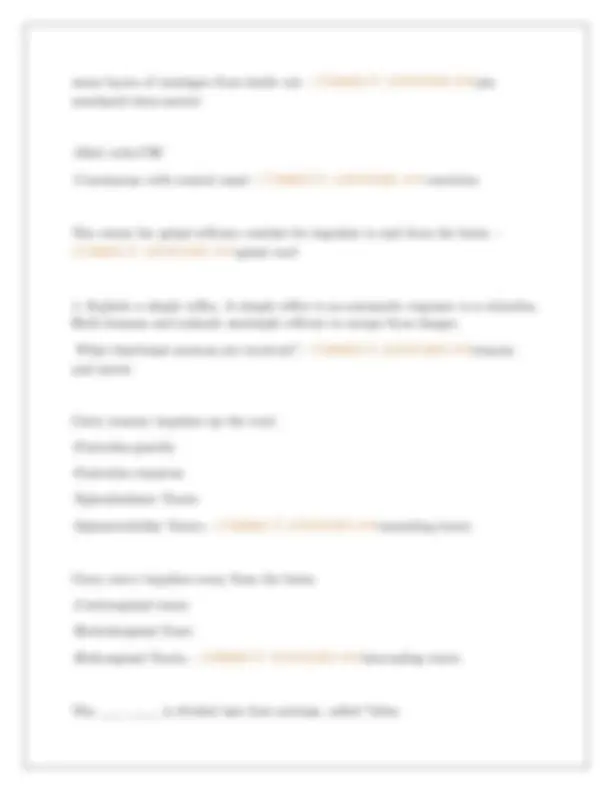
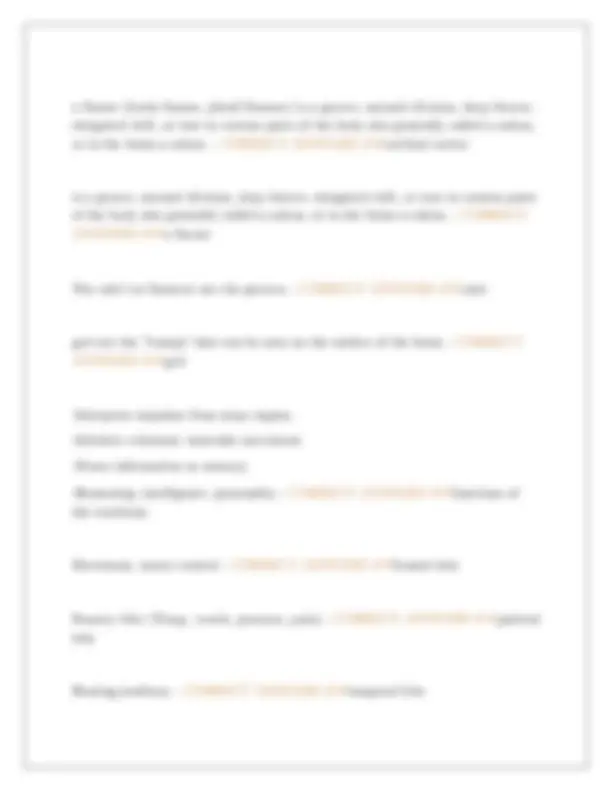


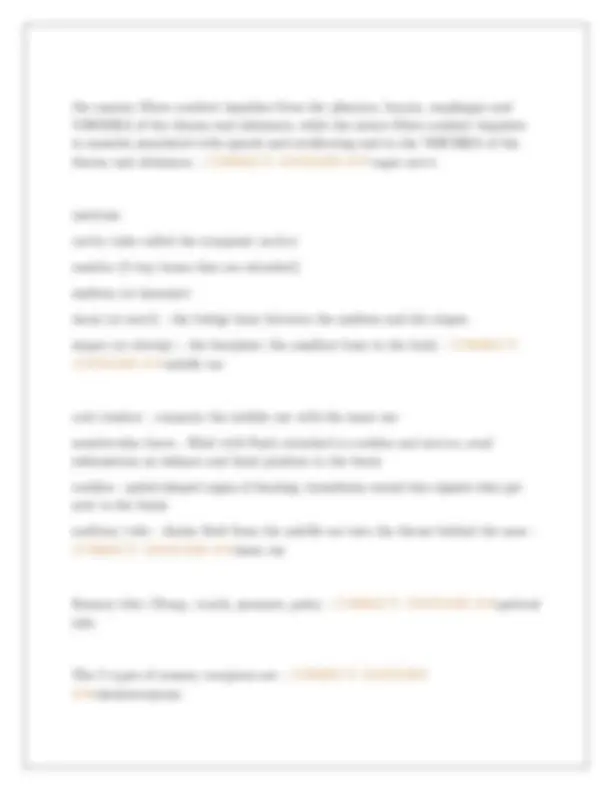
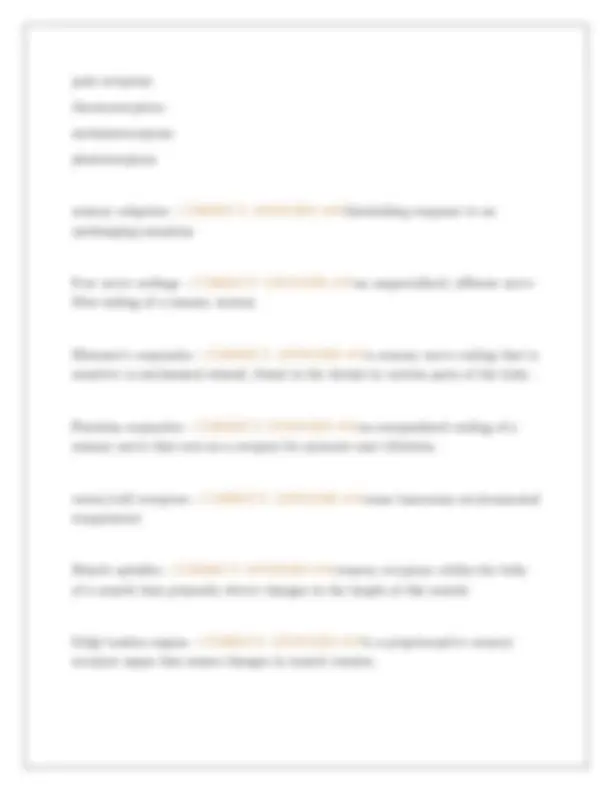
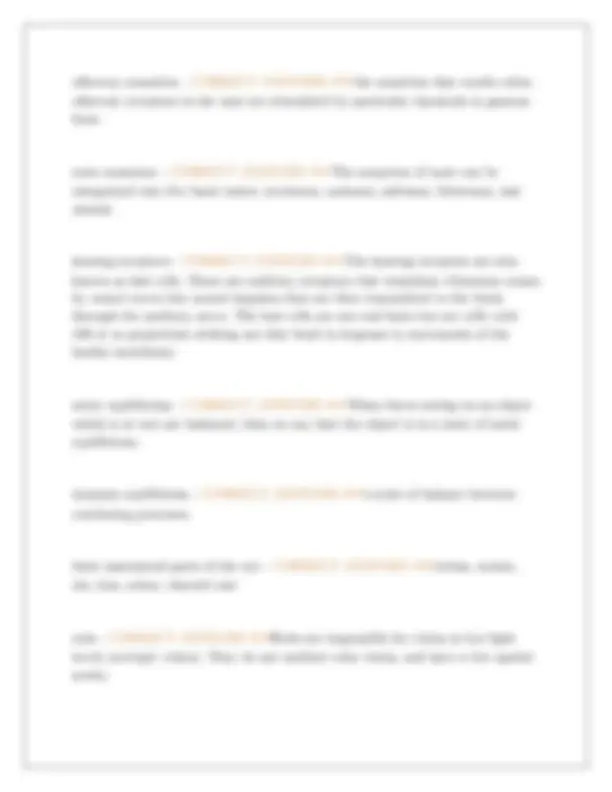



Study with the several resources on Docsity

Earn points by helping other students or get them with a premium plan


Prepare for your exams
Study with the several resources on Docsity

Earn points to download
Earn points by helping other students or get them with a premium plan
Community
Ask the community for help and clear up your study doubts
Discover the best universities in your country according to Docsity users
Free resources
Download our free guides on studying techniques, anxiety management strategies, and thesis advice from Docsity tutors
This study guide provides a comprehensive overview of fundamental concepts in anatomy and physiology, covering key topics such as levels of organization, characteristics of life, requirements of life, homeostasis, basic chemistry, organic molecules, cell structure, and transport mechanisms. It includes multiple-choice questions with answers, offering a valuable resource for students preparing for their final exam in aphy 101.
Typology: Exams
1 / 43

This page cannot be seen from the preview
Don't miss anything!




































The study of structure and the relationships between structures is _______________. - CORRECT ANSWERS ✔✔anatomy The study of the function of body parts is _______________. - CORRECT ANSWERS ✔✔physiology What are the levels of organization and define each. - CORRECT ANSWERS ✔✔Organelles, cells, tissues, organs, organ systems cell structures that carry out special functions in a cell - CORRECT ANSWERS ✔✔organelle basic unit of structure & function in a living thing - CORRECT ANSWERS ✔✔cell A group of similar cells that are organized to do a specific job. - CORRECT ANSWERS ✔✔Tissue A collection of tissues that carry out a specialized function of the body - CORRECT ANSWERS ✔✔organ Group of organs that work together to perform a specific function - CORRECT ANSWERS ✔✔organ system
a living thing made of a group of organ systems - CORRECT ANSWERS ✔✔organism What are the characteristics of Life? - CORRECT ANSWERS ✔✔Movement Responsiveness Growth Reproduction Respiration Digestion Absorption Circulation Assimilation Excretion What are the requirements of life? - CORRECT ANSWERS ✔✔Water food oxygen heat pressure Define homeostasis - CORRECT ANSWERS ✔✔The body's ability to keep its internal conditions stable, so that it's cells can survive What is a homeostatic mechanism? - CORRECT ANSWERS ✔✔Receptors
a weak attraction formed when a hydrogen atom of one molecule is attracted to a slightly negative atom within either the same molecule or a different molecule - CORRECT ANSWERS ✔✔hydrogen bonds the production of chemical compounds by reaction from simpler materials. - CORRECT ANSWERS ✔✔synthesis breakdown is the separation of a chemical compound into elements or simpler compounds - CORRECT ANSWERS ✔✔decomposition a substance that takes part in and undergoes change during a reaction - CORRECT ANSWERS ✔✔reactant The substances that result from this recombination of atoms - CORRECT ANSWERS ✔✔product an electrolyte that dissociates into a hydrogen ion (H+) and an anion - CORRECT ANSWERS ✔✔acid Substances that combine with H+ and make a solution less acidic. Represented by OH- - CORRECT ANSWERS ✔✔base unit of measurement that indicates how many H+ ions are in a solution - CORRECT ANSWERS ✔✔ph scale molecule containing carbon atoms; carbs, proteins, lipids - CORRECT ANSWERS ✔✔organic molecules
chemical substance that is not organic; water, acids, bases - CORRECT ANSWERS ✔✔inorganic molecules chemical reaction in which water is formed during formation of a complex molecule - CORRECT ANSWERS ✔✔dehydration synthesis chemical reaction in which water is used during the breakdown of a complex molecule - CORRECT ANSWERS ✔✔hydrolysis an organic molecule composed of carbon, hydrogen, and oxygen - CORRECT ANSWERS ✔✔carbohydrate any of a class of organic compounds that are fatty acids or their derivatives and are insoluble in water but soluble in organic solvents. They include many natural oils, waxes, and steroids - CORRECT ANSWERS ✔✔lipids organic molecule composed of one or more chains of amino acid monomers - CORRECT ANSWERS ✔✔protein an organic molecule composed of nucleotide monomers; in DNA and RNA. These store genetic information in the cell - CORRECT ANSWERS ✔✔nucleic acid lipid providing long-term energy storage in adipose connective tissue; composed of glycerol and three fatty acids - CORRECT ANSWERS ✔✔Triglycerides
appears as a Double Helix. It appears like a twisted ladder. Within the structures are rungs represented by Four-letter alphabet. The spiral is also made up of sugar and phosphate - CORRECT ANSWERS ✔✔DNA a spiraling thread with bases sticking out towards the center. It also consists of sugar, phosphates and nitrogenous bases - CORRECT ANSWERS ✔✔RNA
function that contains substances that recently entered the cell, store and transport newly synthesized molecules. - CORRECT ANSWERS ✔✔vesicle function this function maintains the integrity of the nucleus, controls the passage of materials between the nucleus and cytoplasm - CORRECT ANSWERS ✔✔nuclear envelope Dense collection of RNA and proteins Site of ribosome production - CORRECT ANSWERS ✔✔nucleolus Carries information for synthesizing proteins (function - CORRECT ANSWERS ✔✔chromatin a protein-lined channel in the nuclear envelope that regulates the transportation of molecules between the nucleus and the cytoplasm - CORRECT ANSWERS ✔✔nuclear pore movement of molecules from a an area of higher to lower concentration down a concentration gradient - CORRECT ANSWERS ✔✔diffusion diffusion of water across a membrane passive process moving from high water concentration to a lower water concentration movement of area of lower solute concentration to higher solute concentration
can occur through simple diffusion or aquaporins - CORRECT ANSWERS ✔✔osomosis passive process where molecules use an integral proteins to cross the bilayer - CORRECT ANSWERS ✔✔facilitated diffusion Hydrostatic pressure important in the body - CORRECT ANSWERS ✔✔filtration Carrier molecules transport substances across a membrane from regions of lower concentration to regions of higher concentration Sugars, amino acids, sodium ions, potassium ions, etc. - CORRECT ANSWERS ✔✔active transport Cell engulfs a substance by forming a vesicle around the substance Three types: Pinocytosis, Phagocytosis, Receptor-mediated - CORRECT ANSWERS ✔✔endocytosis process by which a cell takes in a solid substance - CORRECT ANSWERS ✔✔phagocytosis liquid and small particles dissolved in liquid - CORRECT ANSWERS ✔✔pinocytosis exit out of the cell vesicles fuse with plasma membrane as secretion occurs
A water solution that contains equal numbers of hydrogen ions and hydroxide ions is - CORRECT ANSWERS ✔✔Basic The secondary structure of a protein molecule is the result of - CORRECT ANSWERS ✔✔hydrogen bonds An organic compound always contains - CORRECT ANSWERS ✔✔Carbon Hydrogen Stages of the cell cycle unfold in the following order: - CORRECT ANSWERS ✔✔mitosis, interphase, cytoplasmic division, differentiation Which of the following transport processes does not require expenditure of cellular energy? - CORRECT ANSWERS ✔✔facilitated diffusion A cofactor is ______ and examples are _____. - CORRECT ANSWERS ✔✔enzymes; copper, iron, and zinc An active site of an enzyme is - CORRECT ANSWERS ✔✔the part of an enzyme that combines with a substrate. The aerobic reactions of cellular respiration occur in the mitochondria. (T & F) - CORRECT ANSWERS ✔✔T The type of intercellular junction that consists of fused membranes is a(an) - CORRECT ANSWERS ✔✔Tight junctions
They support and bind nervous tissue and provide nutrients and growth factors to neurons by connecting them to blood vessels - CORRECT ANSWERS ✔✔function of nureglia (An) ______ gland does not branch before reaching the glandular cells or secretory part. - CORRECT ANSWERS ✔✔simple gland The type of intercellular junction that forms tubular channels is - CORRECT ANSWERS ✔✔gap junctions Three physiological factors that affect the color of skin are: volume of blood in dermal vessels, carotene in the subcutaneous layer, and various diseases. (T&F) - CORRECT ANSWERS ✔✔T Skin wrinkles with age because fat is lost from the subcutaneous layer and the dermis shrinks. - CORRECT ANSWERS ✔✔t In treating a burn patient, the "rule of nines" is used to estimate the - CORRECT ANSWERS ✔✔surface area of burn The subcutaneous layer is between the dermis and the epidermis. (T&F) - CORRECT ANSWERS ✔✔F A second degree burn is the same as a full-thickness burn. - CORRECT ANSWERS ✔✔F
Contractile ring pinches cytoplasm in half - CORRECT ANSWERS ✔✔cytokinesis small molecules are built up into larger ones; requires energy. provides the materials needed for cellular growth and repair - CORRECT ANSWERS ✔✔anabolism larger molecules are broken down into smaller ones; releases energy - CORRECT ANSWERS ✔✔catabolism protein that catalyzes a specific biochemical reaction; control rates of metabolic reactions; not consumed in chemical reactions - CORRECT ANSWERS ✔✔enzyme very specifically shaped molecule on which an enzyme acts - CORRECT ANSWERS ✔✔substrate part of an enzyme that temporarily binds a substrate whose shape determines its substrate - CORRECT ANSWERS ✔✔activate sites -disruption of protein folding - CORRECT ANSWERS ✔✔denaturization what causes denaturaization? - CORRECT ANSWERS ✔✔heat and chemicals organic molecule that stores and transfers energy, used in cellular processes - CORRECT ANSWERS ✔✔adenosine triphosphate
-H atoms are released, bind to NAD -produce NADH, which delivers H and high energy electrons to electron transport chain -ADP is phosphorylated to become ATP -2 molecules of pyruvic acid and 2 molecules of ATP are produced - CORRECT ANSWERS ✔✔production of NADH and ATP Where is energy stored in ATP? - CORRECT ANSWERS ✔✔bonds of the phosphate group occur when oxygen is available; pyruvic acid is used to produce acetyl CoA; citric acid cycle begins; electron transport chain functions; carbon dioxide and water are formed; up to 36 molecules of ATP are produced per each glucose molecule - CORRECT ANSWERS ✔✔aerobic reactions Krebs Cycle/AKA citric acid cycle, and electron transport chain/ AKA oxidative phosphorylation via chemiosmosis These are both aerobic and exclusively aerobic - CORRECT ANSWERS ✔✔aerobic respiration stages can proceed under aerobic and anaerobic conditions. - CORRECT ANSWERS ✔✔glycolysis makes a total of 2 ATP - CORRECT ANSWERS ✔✔anaerobic respiration makes up to 38 ATP - CORRECT ANSWERS ✔✔Aerobic respiration
The electron carriers shift between _______ and ________ states as they accept and donate electron - CORRECT ANSWERS ✔✔reduced oxidized Electron Transport chain 2: ____ provides _ electrons to the first carrier in the chain. This process releases energy because the electrons are at a lower energy state after being passed to the first carrier. The energy released is used to drive the transport of ________ ions into the ______________ space. - CORRECT ANSWERS ✔✔NADH 2 hydrogen inter- membrane Electron Transport chain STEP 3: Moving along the chain: This process continues as the _________ are passed to subsequent ________ ________, each at a lower energy state. The energy released with each transfer of electrons is used to drive more protons into the inter-membrane space. - CORRECT ANSWERS ✔✔electrons electron carriers Electron Transport chain Termination: Step 4 This process is completed when the final electron carrier passes electrons to ______, which picks up two ________ ions (H+) and forms water - CORRECT ANSWERS ✔✔oxygen hydrogen double stranded helix made of 2 strands of nucleotides on a backbone of sugar phosphate chain
5-C sugar (deoxyribose), phosphate, and nitrogenous base (adenine, guanine, cytosine, or thymine) - CORRECT ANSWERS ✔✔DNA DNA wrapped about histone forms - CORRECT ANSWERS ✔✔chromosomes building block of nuclei acids; made of a 5-carbon sugar (ribose or deoxyribose), a phosphate group, a nitrogenous base - CORRECT ANSWERS ✔✔nucleiotide All of the RNA in a cell is made by - CORRECT ANSWERS ✔✔DNA transcription __________ begins with the opening and unwinding of a small portion of the DNA double helix to expose the bases on each DNA strand. - CORRECT ANSWERS ✔✔Transcription messenger ribonucleic acid; carries code from DNA to ribosome - CORRECT ANSWERS ✔✔mRNA transfer ribonucleic acid; brings amino acids to ribosome; has an attachment paint for a specific amino acid and a region of 3 bases called an anticodon, attracted to complementary mRNA codons - CORRECT ANSWERS ✔✔tRNA in tRNA, a triplet of nitrogenous bases that is complementary to a specific codon in mRNA - CORRECT ANSWERS ✔✔anticodon in RNA, a three-base "word" that codes for one amino acid (Concept 11.4). Several of these translate into a polypeptide. - CORRECT ANSWERS ✔✔codon